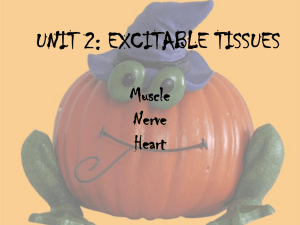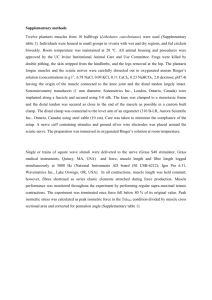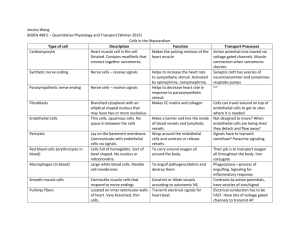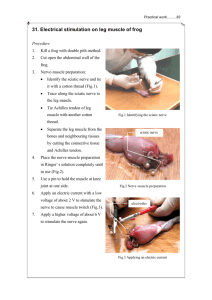The overall morphology of neuromuscular junctions as revealed by
advertisement
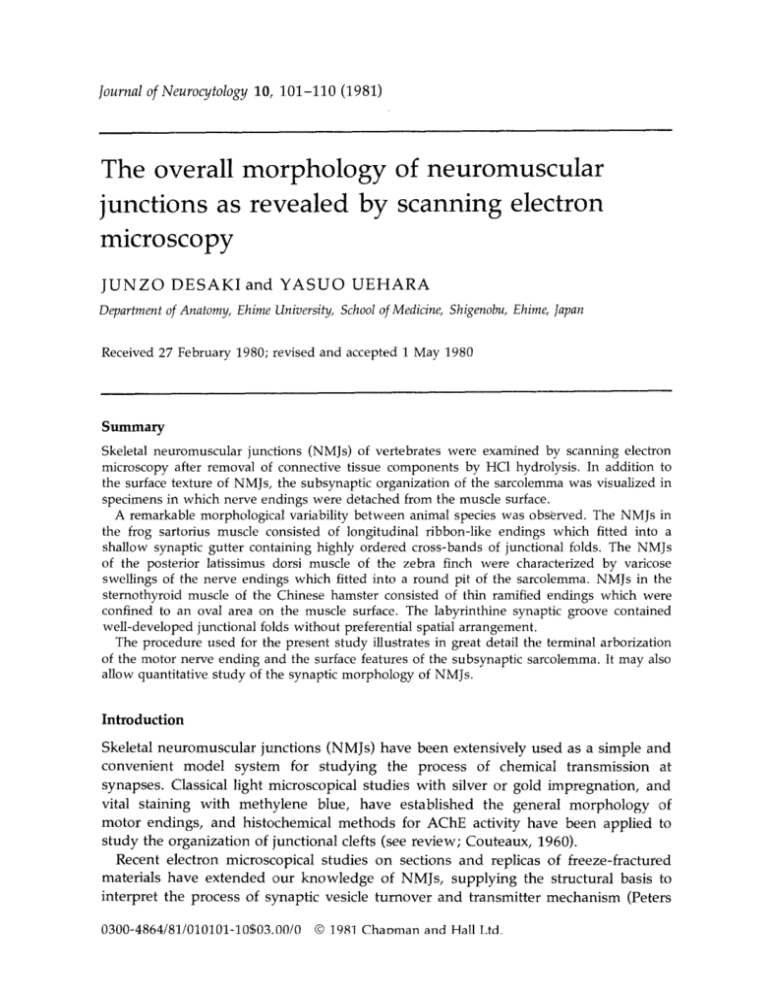
Journal of Neurocytology 10, 101-110 (1981) The overall morphology of neuromuscular junctions as revealed by scanning electron microscopy JUNZO DESAKI and YASUO UEHARA Department of Anatomy, Ehime University, Schoolof Medicine, Shigenobu, Ehime, Japan Received 27 February 1980; revised and accepted 1 May 1980 Summary Skeletal neuromuscular junctions (NMJs) of vertebrates were examined by scanning electron microscopy after removal of connective tissue components by HC1 hydrolysis. In addition to the surface texture of NMJs, the subsynaptic organization of the sarcolemma was visualized in specimens in which nerve endings were detached from the muscle surface. A remarkable morphological variability between animal species was observed. The NMJs in the frog sartorius muscle consisted of longitudinal ribbon-like endings which fitted into a shallow synaptic gutter containing highly ordered cross-bands of junctional folds. The NMJs of the posterior latissimus dorsi muscle of the zebra finch were characterized by varicose swellings of the nerve endings which fitted into a round pit of the sarcolemma. NMJs in the sternothyroid muscle of the Chinese hamster consisted of thin ramified endings which were confined to an oval area on the muscle surface. The labyrinthine synaptic groove contained well-developed junctional folds without preferential spatial arrangement. The procedure used for the present study illustrates in great detail the terminal arborization of the motor nerve ending and the surface features of the subsynaptic sarcolemma. It may also allow quantitative study of the synaptic morphology of NMJs. Introduction Skeletal neuromuscular junctions (NMJs) have been extensively used as a simple and convenient model system for studying the process of chemical transmission at synapses. Classical light microscopical studies with silver or gold impregnation, and vital staining with methylene blue, have established the general morphology of motor endings, and histochemical methods for AChE activity have been applied to study the organization of junctional clefts (see review; Couteaux, 1960). Recent electron microscopical studies on sections and replicas of freeze-fractured materials have extended our knowledge of NMJs, supplying the structural basis to interpret the process of synaptic vesicle turnover and transmitter mechanism (Peters 0300-4864/81/010101-10503.00/0 9 1981 Chapman and Hall Ltd. 102 DESAKI and UEHARA et al., 1976; Heuser & Reese, 1977). There is, however, very little information in the literature concerning the three-dimensional organization of NMJs at the fine structural level, with the exception of a reconstruction carried out by Andersson-Cedergren in 1959. So far, scanning electron microscopic studies have had little success; the main obstacle resides in the presence of connective tissue components which totally conceal the surface of NMJs when examined under the scanning electron microscope. Evan et al. (1976) have extended the applicability of scanning electron microscopy in the survey of tissues and cells by introducing the HCl-coUagenase method for the removal of extracellular connective tissue components. We have applied a modification of this method to the study of NMJs in a variety of vertebrate species. By digesting muscles in collagenase or osmium tetroxide, Shotton et al. (1979) have obtained scanning electron microscopical images of the junctional folds in the frog during the preparation of this manuscript. The entire morphology of the NMJs of the same animal is also examined using the present method. Materials and methods The sartorius muscle of the frog (Rana nigromaculata), the posterior part of the latissimus dorsi muscle of the zebra finch (Uroloncha domestica) and the sternothyroid muscle of the Chinese hamster (Cricetulus griceus) were used. The muscles were fixed in situ by immersion in 3% glutaraldehyde in 0.05 M Na-phosphate buffer (pH 7.3). After excision, the muscles were dissected and were cut into blocks of about 2 x 1 x 1 mm and immersed in fresh fixative for a total of 2 h. The specimens were washed in several changes of buffer and postfixed for 30 min in unbuffered 2% osmium tetroxide. To remove the intramuscular connective tissue components, including collagen and basal laminae, a modification of the method described by Evan et al. (1976) was used. After osmication, the specimens were rinsed in distilled water and then treated with 8 N HC1 for 20-40 rain at 60 ~ C. Treatment with collagenase, as proposed in the original method, was omitted. The preparations were washed in three changes of distilled water for a total of 30 min. They were dehydrated through a graded series of ethanol and were immersed in isoamyl acetate for 30 min. After drying by the critical point method and sputter-coating with gold, the specimens were examined in Hitachi S-310 and S-500A scanning electron microscopes at 5-20 kV. Observations SURFACE FEATURES OF MUSCLE AND NERVE In the specimens where intramuscular connective tissue components are adequately removed, several structures are immediately recognized under the scanning electron microscope. They are muscle fibres, intramuscular nerves and blood capillaries (Figs. 1, 4, 7). Cross-striations of myofibrils are evident along the muscle fibres where the muscle basal lamina appears to be completely removed (Figs. 3, 8). SEM of neuromuscular junctions 103 Intramuscular nerves vary considerably in size and usually have a rather smooth surface. Individual nerve fibres are not visible within a nerve because they are invested by a common perineurial sheath. The nerves ramify repeatedly in the vicinity of the NMJs. The terminal branches correspond in size to single motor nerve fibres in these small experimental animals. Each branch then abruptly tapers to give rise to a nerve ending with a diameter of less than 3/~m. The tapering point indicates the last node of Ranvier. Shortly after the tapering, the nerve ending becomes closely associated with a muscle fibre, lying in a depression or in a set of depressions on the muscle fibre surface to form a NMJ. SURFACE FEATURES OF NMJS AND ORGANIZATION OF SUBSYNAPTIC SARCOLEMMA Profiles of nerve endings, or more exactly those of the Schwann (or teloglial) cells investing the terminal axons are clearly identified on the surface of muscle fibre. The nucleated portions of the Schwann cells appear as spherical or ellipsoidal bulges along the nerve endings. In addition to the surface features, the subsynaptic organization of the sarcolemma is visualized in those specimens in which the nerve endings have been detached from the muscle surface during specimen preparation. The shape and arrangement of the nerve endings and the organization of the subsynaptic sarcolemma vary considerably from one animal species to another. NMJs of the frog In the frog sartorius muscle, each nerve ending is a thin ribbon-like strand less than 2 ~m in width and with a length ranging from 30-200/~m. It runs nearly parallel to the muscle fibre (Fig. 1). A few accessory branches are also noted. A striking feature of the nerve endings of the frog is the presence of small lateral projections of the Schwann cell investment, which is particularly evident in the specimens where the basal lamina appeared to be completely removed (Fig. 2). The projections show a finger-like or knob-like appearance and are less than 0.5 ~m in length. Where the nerve endings are pulled away from the muscle fibres, the surface of the synaptic groove containing junctional folds is exposed (Fig. 3). The groove is about twice as wide as the corresponding nerve ending. A series of narrow slits which represents the openings of the junctional folds are similar in width (about0.2/~m) and are separated by ridges about 0.4/2m wide. This ordered arrangement of the junctional folds is altered at places, particularly at branching points of the ending. NMJs of the finch The nerve endings in the posterior latissimus dorsi muscle of the finch ramify into several branches less than 2 ~m in diameter which are characterized by varicose 104 DESAKI and UEHARA swellings 2-3/~m in diameter (Figs. 4, 5). They tend to be arranged transversely with respect to the axis of the muscle fibre. The S c h w a n n cell bodies associated with the nerve endings are seen as spherical or ellipsoidal bulges about 5/~m in diameter. The synaptic depressions consist of a n u m b e r of r o u n d dimples or pits about 2-3/~m in diameter, into which individual varicosities originally fitted (Fig. 6). There are more than 20 pits per NMJ, a n d junctional folds are f o u n d in some pits (inset of Fig. 6). NMJs of the Chinese hamster The NMJs of the Chinese hamster cover an oval area about 15 by 30/~m in which 2 - 4 profiles of S c h w a n n cell bodies are usually seen. A n u m b e r of thin ramifying nerve endings 2-3/~m in diameter spread out from the cell bodies, which often appear to overlap a n d join each other to form a rather complicated texture (Fig. 7). After the removal of the nerve endings, the junctional sarcolemma exhibits deep a n d irregular synaptic depressions which are incompletely partitioned by ridges or folds of the junctional sarcolemma. The junctional folds are r a n d o m l y disposed with respect to the long axis of the muscle fibre. The complexity in the shape and arrangement of these folds is fully displayed in this type of preparation (Fig. 8). Fig. 1. Surface view of the NMJs in the sartorius muscle of the frog. The side branch (b) of motor nerve (N) abruptly narrows into thin nerve endings (arrows) running along the muscle fibre (M). S, cell bodies of Schwann cells associated with the ending. Scale bar: 10 pm. Fig. 2. Frog nerve endings showing a series of small lateral projections extended from the Schwann cell covering of the endings. Arrow indicates apparent fusion of nerve endings. S, Schwann cell body; M, muscle fibre. Scale bar: 5/~m. Fig. 3. Synaptic gutters and junctional folds of frog NMJs after nerve endings (small asterisks) were detached from the muscle surface. The longitudinal synaptic gutters contain striations due to the junctional folds along the entire length of the gutter. Large asterisk, branching point of the gutter indicating altered arrangement of junctional folds. S, Schwann cell body. Scale bar: 5/~m. Fig. 4. Surface view of a muscle 'bundle of the posterior latissimus dorsi muscle in the finch, showing the distribution of the NMJs (J). The area of the NMJs is partially covered by flattened stellate cells of unknown nature (asterisks). M, muscle fibre. C, capillary associated with the muscle. Scale bar: 10/~m. Fig. 5. NMJs in the finch, showing ramifying nerve ending characterized by varicose swelling (asterisks). S, Schwann cell body; b, side branch of motor nerve. Scale bar: 5 pm. Fig. 6. Synaptic depressions in the sarcolemma of finch NMJ consisting of a group of round pits. A round disc (arrow) is possibly a varicosity of the ending which was left in the pit. g, a gutter imprinted by a blood capillary on the muscle surface. Scale bar: 5/~m. Inset: Junctional folds (arrows) at higher magnification. Scale bar: 1/~m. Fig. 7. Surface view of the NMJs in the sternothyroid muscle of the Chinese hamster. The intramuscular nerve (N) produces thin side branches (b) which terminate on the muscle surface forming NMJs. M, muscle fibre. C, blood capillary with a pericyte (P). Scale bar: 5/~m. Fig. 8. Synaptic depression of the NMJ in the Chinese hamster shows an irregular outline with sarcoplasmic elevations (E) and thin ridges (arrows). Junctional folds which vary considerably in width and length show no preferential spatial arrangement. Scale bar: 5/zm. 108 DESAKI and UEHARA Elevations of the muscle fibre which have a smooth surface and lack any cross-striation are seen in and around each synaptic depression; these are the classical 'endplates' seen by light microscopy. Discussion The present scanning electron microscopical study extends previous light and transmission electron microscopic findings, adding new information on the morphology of NMJs. In order to visualize the surface topography of NMJs, the HCl-collagenase method (Evan et aI., 1976) was modified and applied to remove the intramuscular connective tissue components which conceal NMJs w h e n observed under the scanning electron microscope. It was found that the treatment with HC1 alone removes collagen and basal lamina almost completely and that the digestion with collagenase could be omitted. Another method for the same purpose which consists of enzymatic digestion with collagenase, hyaluronidase and trypsin prior to fixation (Uehara & Suyama, 1978; Nagato, 1978) was also tested but resulted in serious distortion of muscle and nerve, due to muscle contraction during specimen preparation. In our preparations, the surface of the nerve endings was exposed but terminal axons themselves were not visualized owing to the presence of Schwann cells covering their entire length. However, it is k n o w n from transmission electron microscope studies that the Schwan cell investment is generally extremely attenuated (except in the region of the nuclei); so the overall profile of the nerve ending conforms rather closely to the shape of the terminal axon. Small lateral projections which were observed along the edge of the Schwann cell investment in the frog NMJ do not appear to be artifactual structures. Similar profiles are occasionally seen in sectioned material (for example, see Fig. 2, Heuser & Reese, 1973). However, further studies, including reconstruction from serial sections, are needed to ascertain that these projections are genuine structures. The functional significance Of these projections is not known. They may form an attachment device between nerve ending and muscle surface or play some roles in metabolical interaction between the two. Alternatively, they may 'cap' the lateral extensions of the postsYnaptic folds. The round elevations of the junctional sarcoplasm seen in the Chinese hamster undoubtedly correspond to the terminal cone or eminence of Doy6re (1840). The elevations are k n o w n to contain muscle nuclei and accumulations of mitochondria and sarcoplasmic reticulum. They are characterized by the absence of cross-striations of myofibrils on their surface. These features would suggest that the elevations are a flexible and easily deformable structure depending on the state of muscle contraction, as was pointed out by Rouget (1862). Kfihne (1887) also noted that the elevations become quite prominent w h e n the muscle fibre is contracted. At the NMJs, nerve ending and muscle fibre are closely adherent. The entire SEM of neuromuscular junctions 109 muscle membrane is ripped away with nerve membrane when the nerve is pulled in fixed tissue (Couteaux, 1952), and application of purified collagenase is insufficient to break the adhesion (McMahan et al., 1972). Only by long treatment with proteases would the two structures be separated (Betz & Sakmann, 1973). In the present study, however, we show that treatment with HC1 allows the nerve ending to be easily pulled away from the muscle surface, possibly by hydrolysing components of the basal lamina in the synaptic clefts. This provides an opportunity to obtain an en face view of the synaptic depressions in which narrow clefts representing the slit-like entrances of the junctional folds are evident. The present study illustrates the morphological variability of NMJs between different animal species which has already been extensively reported in the past (for example, Couteaux, 1960). The most striking difference is manifest in the organization of the synaptic depressions. In the frog, they appear as a shallow longitudinal gutter which contains highly ordered cross-bands of the junctional folds. Those in the finch consist of a group of round pits in which junctional folds are poorly developed, and those in the Chinese hamster show a meandering and irregular outline in which a n u m b e r of junctional folds are randomly disposed with respect to the muscle fibre axis. In addition to the variability between animal species, two types of NMJs, the single en plaque type and multiple en grappe type, have been noted to innervate fast twitch muscle fibres and slow tonic fibres respectively in the same animal. Comparison of these two types of NMJs is in progress with the procedure applied for the present study, using the posterior and anterior parts of the avian latissimus dorsi muscle (Ginsborg & Mackay, 1961; Hess, 1961; Page, 1969; Atsumi, 1977). The method used for this study can be used to conduct straightforward quantitative studies of the shape and organization of NMJs, though it involves treatment with high concentration of HC1 which does produce some degree of tissue shrinkage and distortion. Acknowledgements The authors are grateful to Dr Giorgio Gabella of University College London for his critical reading of the manuscript and valuable suggestions. References ANDERSSON-CEDERGREN, E. (1959) Ultrastructure of motor endplate and sarcoplasmic components of mouse skeletal muscle fibers as revealed by three dimensional reconstructions from serial sections. Journal of Ultrastructure Research Suppl. 1, 5-181. A T S U M I , S. (1977) Development of neuromuscular junctions of fast and slow muscles in the chick embryo: a light and electron microscopic study. Journal of Neurocytology 6, 691-709. BETZ, W. & SAKMANN, B. (1973) Effect of proteolytic enzymes on function and structure of frog neuromuscular junctions. Journal of Physiology 230, 673-88. 110 DESAKI and UEHARA COUTEAUX, R. (1952) In Le muscle. Etude de Biologie et de Pathologie (edited by C.C.I.C.M.S.), pp. 173-183. Paris: L'Expansion Scientifique. c OUTEAUX, R. (1960) Motor end-plate structure. In The Structure and Function of Muscle (edited b y BOURNE, G. H.), Vol. 1, pp. 337-380. N e w York: Academic Press. DOYI~RE, L. (1840) Memoire sur de les tardigrades. Annals de Sciences Naturelles Zoologie 14, 269-361. EVAN, A. P., DAIL, W. G., DAMMROSE, D. & PALMER, C. (1976) Scanning electron microscopy of cell surfaces following removal of extracellular material. Anatomical Record 185, 433-46. GINSBORG, B. L. & MACKAY, B. (1961) A histochemical demonstration of two types of motor innervation in avian skeletal muscle. Bibliotheca Anatomica 2, 174-81. HESS, A. (1961) Structural differences of fast a n d slow extrafusal muscle fibres a n d their nerve endings in chicken. Journal of Physiology 157, 221-31. HEUSER, J. E. & REESE, T. S. (1973) Evidence for recycling of synaptic vesicle m e m b r a n e during transmitter release at the frog neuromuscular junction. Journal of Cell Biology 57, 315-44. HEUSER, J. E. & REESE, T. S. (1977) Structure of the synapse. In Handbook of Physiology (edited b y BROOKHART, J. M. and MOUNTCASTLE, V. B.), Vol. 1, pp. 261-294. Bethesda: American Physiological Society. KUHNE, W. (1887) Neue U n t e r s u c h u n g e n fiber motorische N e r v e n e n d i g u n g e n . Zeitschrift f~r Biologie 23, 1-148. McMAHAN, U. J., SPITZER, N. S. & PEPER, K. (1972) Visual identification of nerve terminals in living isolated skeletal muscle. Proceedings of the Royal Society of London, Series B 181, 421-30. NAGATO, T, (1978) Scanning electron microscopical image of myoepithelial cells. Journal of Electron Microscopy 27, 235-6. P A G E , S. G. (1969) Structure and some contractile properties of fast and slow muscle of the chicken. Journal of Physiology 205, 131-45. PETERS, A., PALAY, S. L. & WEBSTER, H. deF. (1976) Synapses. In The Fine Structure of the Nervous System: The neurons and supporting cells (edited by PETERS, A., PALAY, S. L. and WEBSTER, H. deF.), pp. 118-180. Philadelphia: Saunders. ROUGET, C. (1862) Note sur la terminaison des nerfs m o t e u r s dans les muscles chez les reptiles, les oiseaux et les mammif6res. Comptes rendu hebdomadaire des s~ances de l'Acad~mie des sciences 55, 548-51. SHOTTON, D. M., HEUSER, J. E., REESE, B. F. & REESE, T. S. (1979) Postsynaptic m e m b r a n e folds of the frog neuromuscular junction visualized by scanning electron micrcoscopy. Neuroscience 4, 427-35. UEHARA, Y. & SUYAMA, K. (1978) Visualization of the adventitial aspect of the vascular smooth muscle cells u n d e r the scanning electron microscope. Journal of Electron Microscopy 27, 157-9.

